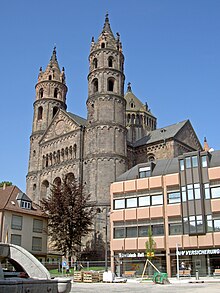This article needs additional citations for verification. (July 2015) |
| Worms Cathedral | |
|---|---|
| St. Peter's Cathedral | |
Wormser Dom | |
 The east end of the Cathedral. | |
 | |
| 49°37′49″N 8°21′35″E / 49.63028°N 8.35972°E | |
| Location | Worms, Rhineland-Palatinate |
| Country | Germany |
| Denomination | Roman Catholic |
| Website | pg-dom-st-peter-worms |
| History | |
| Former names | Cathedral Church of St. Peter of Worms |
| Founder(s) | Berthulf of Worms |
| Architecture | |
| Previous cathedrals | 2 |
| Architectural type | Romanesque |
| Years built | 1130–1181 |
| Specifications | |
| Nave height | 26 m (85 ft) |
| Number of spires | 4 |
| Bells | 8 |
| Tenor bell weight | 2,855 kg (6,294 lb) |
| Administration | |
| Province | Freiburg |
| Diocese | Mainz |
| Clergy | |
| Provost | Tobias Schäfer |
| Pastor(s) | Max Wagner |
| Chaplain(s) | P. Jiří Landa |
| Deacon(s) | Hans-Jürgen Springer |
| Laity | |
| Organist/Director of music | Daniel Wolf |
| Organist(s) | Dan Zerfaß |


St Peter's Cathedral (German: Wormser Dom) is a Roman Catholic church and former cathedral in Worms, southern Germany.
The cathedral is located on the highest point of the inner city of Worms and is the most important building of the Romanesque style in Worms. It is closely associated with Bishop Burchard and the high point of Worms' history in the 12th and 13th centuries. It was the seat of the Catholic Prince-Bishopric of Worms until its extinction in 1802, during German mediatisation, whose prince-bishops resided next door in the Bischofshof palace.
After the extinction of the bishopric, it was reduced in status to that of a parish church; however, it was bestowed the title of minor basilica in 1925 by Pope Pius XI.
Most of the cathedral was finished by 1181, however the west choir and the vaulting were built in the 13th century, the elaborate south portal was added in the 14th century, and the central dome has been rebuilt.[1]

Great events associated with the cathedral include the nomination of Leo IX as Pope in 1048, the Concordat of Worms which ended the Investiture controversy in 1122, the marriage of Emperor Frederick II to Isabella of England in 1235 and the Diet of Worms in 1521, during which Martin Luther was condemned as a heretic.
- ^ One or more of the preceding sentences incorporates text from a publication now in the public domain: Chisholm, Hugh, ed. (1911). "Worms". Encyclopædia Britannica. Vol. 28 (11th ed.). Cambridge University Press. pp. 832–833.